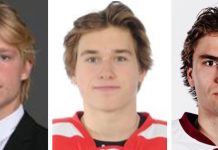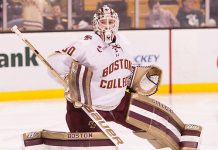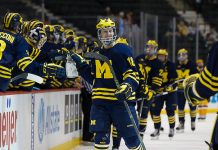So, I suppose the best way for me to start would be by answering that nagging question…why haven’t I written anything substantial about Chay Genoway of North Dakota?
Clearly, it’s because of my malicious East Coast bias, isn’t it?
In all seriousness, I haven’t had a chance to get a good look at Genoway, but as a defenseman averaging more than a point-per-game on a Fighting [CENSORED] team that’s No. 2 in the country with precious few signs of those previous first-half struggles, he certainly should be on the radar.
That said, it may well be a good thing that I haven’t had a chance to watch Genoway closely. After all, this past weekend, I took the opportunity to take a closer look at Princeton’s Zane Kalemba and Quinnipiac’s Brandon Wong, and what did I get? Kalemba’s backup, Alan Reynolds, backstopping the Tigers to an overtime win over Dartmouth, and Wong going without a point in a 4-2 win over the Big Green.
Translation: a rough weekend for my alma mater, and almost as rough an outing for my Hobey candidate viewing.
I say “almost,” because while I didn’t get to see much from Wong – except for the attention he commanded from the Big Green throughout the game – I got a good look at his Bobcats teammate Eric Lampe, who is shaping up to be as strong a Hobey candidate as Wong, despite not having put up eye-popping numbers before this season.
Of course, the fact is that he had no numbers to speak of against Dartmouth, having a point-free night after burning Harvard for a hat trick and an assist the night before. That said, he was a major presence for the Bobcats, particularly on the penalty kill, where he was relentless in pressuring the point, leading to multiple shorthanded opportunities and more than one early end for a Big Green power play.
That kind of play is huge for the Bobcats, who play the hockey equivalent of what Virginia Tech football fans call “BeamerBall.” The Bobcats are always looking for scoring opportunities, whethere it’s even strength, power play, or penalty kill, and as I saw on Saturday, Lampe has been an even bigger part of that than his 14 points in nine games suggest.
And if you don’t believe me, just ask his coach.
“Brandon’s having a very good year,” Rand Pecknold told me after the game on Saturday, “and his numbers show that, but Eric Lampe’s been excellent. He’s our best player. He’s been absolutely dominant in eight of those nine games, and not just from an offensive standpoint. He’s great on the penalty kill. He’s great defensively. We’ve got a lot of guys playing well right now. He’s been our best player.”
Of course, none of this is to say that Wong may not eventually emerge as the top Hobey candidate on this Bobcats team, even if Lampe is the best player. You can certainly make arguments for Hobey winners who weren’t the best players on their teams, albeit usually when there was another Hobey finalist on the team. We heard it from some quarters last year, arguing that Colin Wilson was more Hobey-worthy than winner Matt Gilroy (I disagreed then, and I disagree now). It was certainly part of the conversation in 2005, vis-a-vis Marty Sertich and Brett Sterling, and while I wasn’t even in college yet in the spring of 2000, looking back, you could have made the argument for Brian Gionta over Mike Mottau.
Also, at some point, it does become a question of numbers, and with a 27-goal season on his resumé, Wong may go on to have the better season for Hobey purposes. As Pecknold points out, he has a lot of players performing well right now (keep an eye on sophomore Scott Zurevinski, while we’re at it, if not for this year than for the future).
“,” Pecknold said.
Of course, all of this said, it begs an important question, and it’s a question that also affects a guy like Matt Read of Bemidji State – whom I was asked about on Hockey on Campus last week – or Nick Schaus of UMass Lowell for that matter (and I was VERY impressed with him when I watched the River Hawks beat UNH on ESPN U weekend before last).
The question is: how much does a school’s brand name mean for winning the Hobey?
Now, obviously, the schools with the biggest names tend to attract a lot of talent, so in that sense, it’s hardly a surprise that the Hobey has gone exclusively to players from big-time hockey programs (I include Bowling Green in that program’s heyday in that statement).
Of course, we don’t have this problem in NCAA tournament selection, as the basketball folks do (and really, I’ll take the KRACH arguments over basketball’s tournament grousing every day of the week and twice on Selection Sunday). However, it is worth noting that no player has won the Hobey while playing at a school that couldn’t be considered a national hockey power at the time, and no matter what Quinnipiac and Lowell do this year, that kind of recognition takes some time to build up. Heck, Notre Dame and Miami are just starting to reach national power status now, and it’s taken consistent NCAA tournament presence and a national championship game berth apiece to get there.
In that light, it’s worth asking whether the fact that Brandon Wong or Nick Schaus could have a harder road to the Hobey than, say, Cornell’s Colin Greening or New Hampshire’s Blake Kessel, even though they play in the same conferences, because Wong and Schaus play at Quinnipiac and Lowell, respectively.
I’m not sure myself. What do you guys think?


